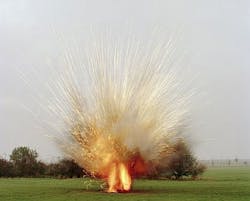INDIAN HEAD, Md., 19 Oct. 2012. U.S. Navy researchers are asking industry to design a handheld modified over ground access sensor (OGAS) to help special operations forces operating on foot to locate and neutralize land mines that are not made of metal.
The Naval Surface Warfare Center in Indian Head, Md., on Tuesday issued a presolicitation (N0017413R0007) for the Modified Over Ground Access Sensor (OGAS) program, which seeks to develop a fast, mobile land mine detector for locating non-metallic buried explosives.
Most commercially available OGAS locators are designed for humanitarian de-mining, and so are not appropriate for special operations forces operating on foot. The Modified OGAS program is asking for industry bids on developing a locator system for Navy explosive ordnance disposal (EOD) Special Operations Forces (SOF), and Naval SOF (NAVSOF) dismounted operations.
Speed and mobility of the kind of OGAS sensor that researchers are looking for are primary considerations in this solicitation. No capability is available today in a handheld form factor that can detect, pinpoint, and provide data necessary to enable EOD and NAVSOF/SOF operators to avoid low-magnetic-content (LMC) and no-magnetic-content (NMC) objects, Navy researchers say.
Market research indicates that current COTS OGAS locators could be redesigned with lower size and weight with no loss in capability, and suitable for operators on foot, researchers say. More details will be available when a formal solicitation is issued.
Researchers say they expect to award firm-fixed-price contracts to two companies as a small-business set aside. The contract will include three phases.
The first phase will call for the two selected contractors to deliver four prototypes. The second phase will downselect one contractor to continue development, and build 10 production models of the detector. The third and final phase will call for the contractor to build and deliver as many as 50 OGAS detector units.
Navy researchers have not indicated when they will issue a formal solicitation for the Modified OGAS program. Companies that have indicated interest thus far are Synetics Systems Engineering in Yorba Linda, Calif.; Folkman Inc. in Green Bay, Wis.; and Kestrel Corp. in Albuquerque, N.M.
Companies interested may contact the Navy's Amanda Woodard by phone at 301-744-6657 for more information. Additional information is online at https://www.fbo.gov/spg/DON/NAVSEA/N00174/N0017413R0007/listing.html.
Follow Military & Aerospace Electronics and Avionics Intelligence news updates on Twitter



